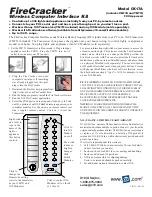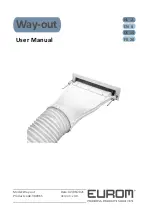
Safety Instructions
4
900-0258-01-00 Rev A
Important Safety Instructions
READ AND SAVE THESE INSTRUCTIONS!
This manual contains important safety instructions for the EnergyCell battery. These instructions
are in addition to the safety instructions published for use with all OutBack products. Read all
instructions and cautionary markings on the EnergyCell battery and on any accessories or
additional equipment included in the installation. Failure to follow these instructions could result in
severe shock or possible electrocution. Use extreme caution at all times to prevent accidents.
WARNING: Personal Injury
Some batteries can weigh in excess of 100 lb (45 kg). Use safe lifting techniques when
lifting this equipment as prescribed by the Occupational Safety and Health Association
(OSHA) or other local codes. Lifting machinery may be recommended as necessary.
Wear appropriate protective equipment when working with batteries, including eye or
face protection, acid-resistant gloves, an apron, and other items.
Wash hands after any contact with the lead terminals or battery electrolyte.
WARNING: Explosion, Electrocution, or Fire Hazard
Ensure clearance requirements are strictly enforced around the batteries.
Ensure the area around the batteries is well ventilated and clean of debris.
Never smoke, or allow a spark or flame near, the batteries.
Always use insulated tools. Avoid dropping tools onto batteries or other electrical parts.
Keep plenty of fresh water and soap nearby in case battery acid contacts skin, clothing,
or eyes.
Wear complete eye and clothing protection when working with batteries. Avoid touching
bare skin or eyes while working near batteries.
If battery acid contacts skin or clothing, wash immediately with soap and water. If acid
enters the eye, immediately flood it with running cold water for at least 20 minutes and
get medical attention as soon as possible.
Never charge a frozen battery.
Insulate batteries as appropriate against freezing temperatures. A discharged battery
will freeze more easily than a charged one.
If a battery must be removed, always remove the grounded terminal from the battery
first. Make sure all devices are de-energized or disconnected to avoid causing a spark.
Do not perform any servicing other than that specified in the installation instructions
unless qualified to do so and have been instructed to do so by OutBack Technical
Support personnel.
Additional Resources
These references may be used when installing this equipment. Depending on the nature of the
installation, it may be highly recommended to consult these resources.
Institute of Electrical and Electronics Engineers (IEEE) guidelines: IEEE 450, IEEE 484, IEEE
1184, IEEE 1187, IEEE 1188, IEEE 1189, IEEE 1491, IEEE 1578, IEEE 1635, and IEEE 1657
(various guidelines for design, installation, maintenance, monitoring, and safety of battery systems)
Summary of Contents for Outback Power EnergyCell 1000XLC
Page 1: ...EnergyCell 1000XLC Owner s Manual...
Page 10: ...Introduction 10 900 0258 01 00 Rev A This page intentionally left blank...
Page 28: ...Operation 28 900 0258 01 00 Rev A NOTES...
Page 32: ...Troubleshooting and Maintenance 32 900 0258 01 00 Rev A NOTES...
Page 35: ...EnergyCell Batteries 900 0258 01 00 Rev A 35 This page intentionally left blank...





































